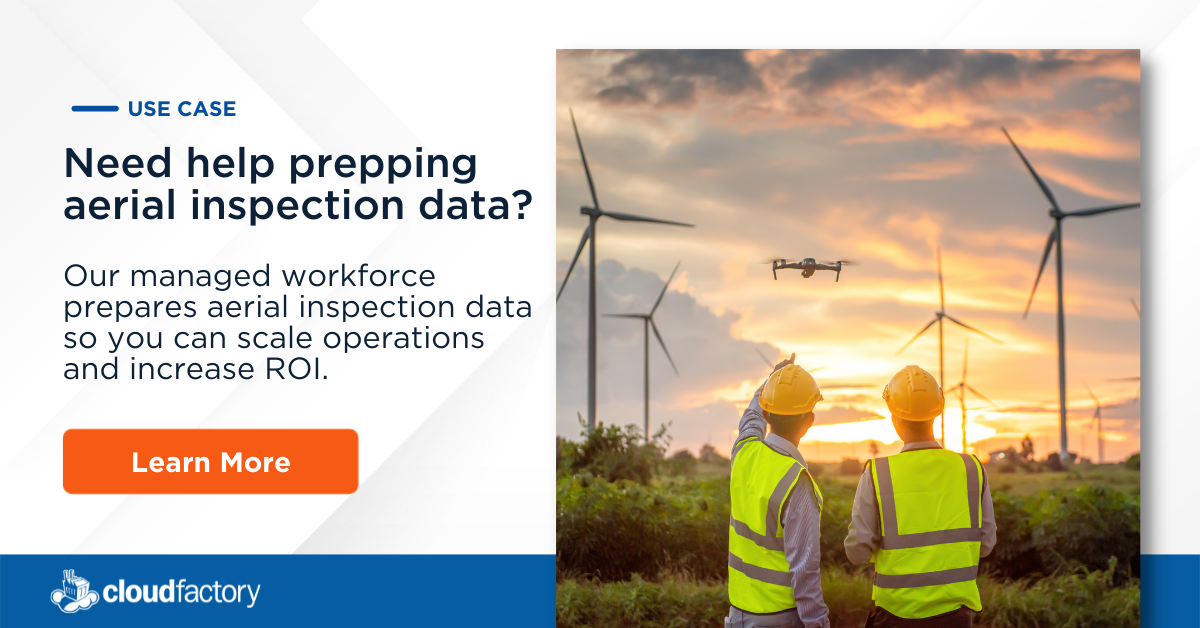Challenging economic times are driving heavy industries to adopt AI to reduce the cost of asset inspection and management dramatically. How? By unlocking hands-free insights from high-quality aerial and geospatial computer vision (CV) images, point cloud, orthomosaics, and digital twin data.The on-demand webinar AI Innovation in Industrial Asset Management digs into practical AI use cases and uncovers considerations for adoption, including the role of humans in the loop (HITL) for training and sustaining AI/ML models. You’ll walk away with insight into:
- Key trends behind industrial asset inspection and management.
- CV application use cases across various industries.
- Steps to implement projects efficiently and effectively.
- Benefits of a HITL strategy to accelerate AI projects.
If you don't have time to watch the entire webinar today, here are 5 key takeaways from the AI Innovation in Industrial Asset Management webinar:
1. Alternatives to manual approaches
Tristan Rouillard, VP of Machine Learning Solutions at CloudFactory, unpacks how aging industrial assets globally coupled with rising labor costs and limited skilled technicians are forcing companies to seek out lower-cost alternatives over manual approaches which have been in place for many decades.
💡 According to Uptake, the average facility in oil and gas loses 32 hours of productivity each month to unplanned downtime. This translates to a cost of $220,000 per hour and rounds up annually to $84 million at each facility.
2. Tech advances unlocking possibilities
Advances such as drones and UAVs with high-resolution cameras that capture visual data and advanced ML tooling and processing capabilities have unlocked a rapidly growing industry projected to exceed $33B by 2030.
3. Limitations of visual inspection
Adam Petruszka, Director of Business Development at Abyss Solutions, unveils how visual inspections are costly, inefficient, subjective, and provide incomplete asset coverage.
"In the real world today, there are limitations with visual inspections that are done for asset integrity and asset management. One of the first things is that the inspections are performed by humans, and every human is different in their productivity and in their interpretation or perceptions. And, on top of that, let's face it, every human can have a bad day. So, as a result, you end up getting different levels or different subjective interpretations of the condition of an asset. Computer vision and machine learning models follow a standard. So they constantly crawl through the imagery. They are not taking breaks. They're not getting distracted. They're 100% focused. And so you get an objective level of analysis that you typically don't see from human factors."
-Adam Petruszka, Director of Business Development, Abyss Solutions
4. Benefits of moving to autonomous inspections
Adam shares how one of their customers, which transitioned to autonomous inspections using CV data, achieved a 50% inspection budget reduction, plus reduce the risk on maintenance and improve their asset’s uptime in the process.
5. Transition to data-centric ML
Tristan unpacks how AI leaders are moving from a traditional waterfall approach and evolving from model-centric to data-centric ML. He shares how iterative ML speeds up the time to market due to built-in feedback loops throughout the process by embracing humans in the loop to achieve higher-quality outcomes.
The webinar is worth the watch if you're seeking in-depth information about autonomous inspections for industrial asset management.
How CloudFactory can help you gain valuable insights from your aerial inspection data
Quality inputs yield quality outputs, which is why extracting valuable insights from data collected by drones and terrestrial systems begins with quality data processing and annotation. CloudFactory’s managed human-in-the-loop workforce has expertise in labeling 2-D and 3-D images and video, plus sensor, point cloud, orthomosaic, digital twin, and LiDAR data, so your team can gain valuable insights quickly while optimizing your operational costs.
In addition, our recently launched Accelerated Annotation, an AI-assisted labeling solution for 2-D images, learns and adapts to your use case to improve annotation speed and quality. This product blends the best AI-powered automation and human expertise to deliver accurate labels for image datasets 5x faster.
Learn more about how CloudFactory prepares aerial inspection data so you can scale operations and improve asset management.
Data Labeling Computer Vision Geospatial Drones Drone Inspection



